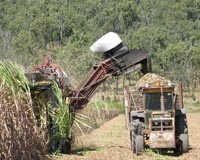 |
Ames IW (SPX) Apr 21, 2011 David Grewell flipped on the augers that carry corn from a truck to a biorefinery. Then, with a few more clicks of his computer mouse, he turned on the pumps that send grain all the way through an ethanol plant, from storage to hammer mill to slurry tanks to jet cooker to liquefaction, fermentation, distillation, water separation and ultimately to ethanol storage. Don't forget the centrifuges, evaporators and driers that recover distillers grains for livestock feed. All of this happened in a small office on the north side of the Food Sciences Building and the Center for Crops Utilization Research at Iowa State University. Grewell, an associate professor of agricultural and biosystems engineering, calls his virtual control room "Nintendo for biofuel nerds." But I-BOS (the Interactive Biorefinery Operations Simulator) is no game. It's based on real Iowa biorefineries that are producing ethanol and biodiesel. It's designed to help students in Iowa State's biorenewable resources and technology program learn about biofuel production. And it could be used by the biofuel industry to help train employees to operate a biorefinery. "This could be the major component of a curriculum for teaching biofuels operators how to run a plant," Grewell said. "It's like a flight simulator for pilots." And like a good flight simulator, the virtual control room is calibrated to match real-world performance. It's based on differential calculations that describe the fundamental transport phenomena and incorporate the principles of mass and energy conservation. The simulations also take into account more than 20 specific production attributes including moisture, starch content, contaminants, temperature and particle size. All the attributes change as biomass is converted into biofuel. And they can be changed by instructors, giving students experience with a variety of production conditions. The virtual control room is now written to simulate the operation of ethanol and biodiesel plants. It keeps track of energy consumption, production efficiency and fuel quality. It also features interactive video clips from real biofuel plants that give students a good look at the entire production process. It can also give them an inside look at a plant emergency. The virtual control room, for example, can simulate a fire in an ethanol plant's distillation column, right down to a red emergency light flashing on the control room wall. "Students will have to respond to the fire and learn what to turn off to minimize and contain the damage," Grewell said. The virtual control room can also offer training and experience with new feedstocks and technologies. Grewell said as new ideas are developed, and as researchers understand the processes and conversions, feedstocks such as cellulose from plants or oil from algae can be written into the simulations. The virtual control room was built by Grewell, Melissa Montalbo-Lomboy, a post-doctoral research associate; Priyanka Chand, a doctoral student; Christopher Rempe, a senior in industrial technology; and former students David Chipman and Yuriy Gritsenko. The project is supported by a three-year, $300,000 grant funded by the U.S. Department of Agriculture, the Renewable Energy Group Inc. of Ames, Lincolnway Energy of Nevada, Fastek International of Cedar Rapids, Cargill, Crown Iron Works Co. and Emerson Electric Co. Grewell said there's a reason industry is helping to support the research project. "This project will increase the productivity of biorefineries," Grewell said. "Companies will be better able to train their workers. And those workers will have less of a learning curve."
Share This Article With Planet Earth
Related Links Iowa State University Bio Fuel Technology and Application News
 Sugarcane Cools Climate
Sugarcane Cools ClimatePalo Alto CA (SPX) Apr 19, 2011 Brazilians are world leaders in using biofuels for gasoline. About a quarter of their automobile fuel consumption comes from sugarcane, which significantly reduces carbon dioxide emissions that otherwise would be emitted from using gasoline. Now scientists from the Carnegie Institution's Department of Global Ecology have found that sugarcane has a double benefit. Expansion of the crop in a ... read more |
|
| The content herein, unless otherwise known to be public domain, are Copyright 1995-2010 - SpaceDaily. AFP and UPI Wire Stories are copyright Agence France-Presse and United Press International. ESA Portal Reports are copyright European Space Agency. All NASA sourced material is public domain. Additional copyrights may apply in whole or part to other bona fide parties. Advertising does not imply endorsement,agreement or approval of any opinions, statements or information provided by SpaceDaily on any Web page published or hosted by SpaceDaily. Privacy Statement |